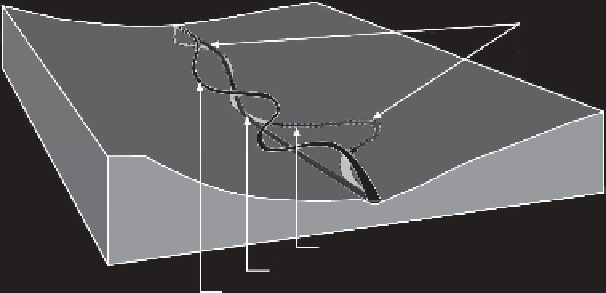Environmental Engineering Reference
In-Depth Information
waterbodies. For example, a stream may not have suficient lows to maintain satisfactory hydraulic
connections so that portions of the old channel are no longer connected (Figures 8.33 and 8.34);
therefore, either low or water surface elevation management is required. Sedimentation can require
extensive maintenance (FISRWG 1998).
8.4.23 r
eSearcH
Research is fundamental to improving the development of methods and tools for stream restora-
tion, both for site modiications and for education. In addition, while there are numerous restoration
projects completed or underway, research and monitoring are needed to determine the effectiveness
of those projects (postaudit studies) over time and under variable environmental conditions. For
example, as discussed previously, postaudit monitoring and research can provide critical informa-
tion for understanding why techniques and practices work, and, equally important, why some fail
(Saldi-Caromile et al. 2004).
8.4.24 r
eVeGetatIon
Revegetation is the reestablishment of plant cover by means of seeding or transplanting on a site
disturbed by natural or human-caused actions.
8.4.24.1 Revegetation: Seedlings/Saplings
This technique of erosion control is based on the assumption that soil can be kept in place with a
vegetative cover (Long et al. 1982). The revegetation of seedlings is a long-term measurement that
is appropriate for exposed soils that have the potential to erode sediments.
8.4.24.2 Revegetation: Live Stake
This technique involves inserting dormant cuttings directly into the ground, which root and have the
ability to grow and act as stakes (Heaton et al. 2002). This system of stakes creates a living root mat
that stabilizes the soil by reinforcing and binding soil particles together and by extracting excess
soil moisture. Live stakes must be cut from dormant materials. Mature stems with diameters of over
3 cm work best. The live stake technique is recommended for streambank protection where the site
conditions are uncomplicated, construction time is limited, and an inexpensive method is needed
(Figure 8.35; NRCS 1996b).
Reconnected
abandoned
channel
(with control)
Historical alignment
Previous alignment
Restoration alignment
FIGURE 8.33
Maintenance of hydraulic connections. (From FISRWG,
Stream Corridor Restoration:
Principles, Processes, and Practices
, Federal Interagency Stream Restoration Working Group, 1998.)

Search WWH ::

Custom Search